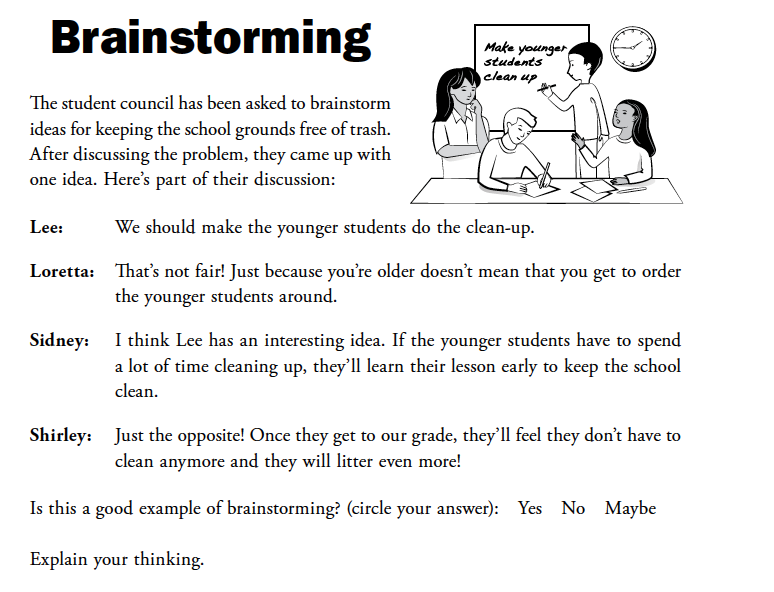Formative Assessment Probes
What Is Brainstorming?
Brainstorming is a hallmark strategy of designers that allows everyone on a design team to contribute to potential solutions. When engineers engage in brainstorming, they freely generate as many ideas as possible, even if they seem impractical. Brainstorming is an important technique that students learn to use with engineering design problems. You can introduce students to brainstorming by starting with the formative assessment probe, “Brainstorming” (Keeley, Sneider, and Ravel 2020). The probe uncovers the extent to which students understand the norms of good teamwork during the process of generating ideas for possible solutions. It also informs next steps for instruction to help students learn, practice, and use the process of brainstorming.
Students may have several ideas for why the probe scenario discussion about solutions for keeping the school grounds free of trash is a good example of brainstorming. This may be because they are used to focusing on one idea at a time and evaluating it before coming up with other ideas. However, the best answer is that the scenario is not a good example of brainstorming. Once a problem has been defined and researched, brainstorming is used by a team to generate as many creative ideas as possible, without evaluating or criticizing ideas during the process. The scenario in this probe illustrates how violating rules for brainstorming stops the creative free flow of ideas and divergent thinking and results in a small number of ideas.
Students may identify the importance of not passing judgement on others’ ideas during brainstorming yet not be aware of the critical need for quantity of ideas. Typically, students are told to focus on quality, not quantity in their school work. When brainstorming during an engineering design problem, quantity is more important than quality. Teams need to capture as many ideas as they can, even if they seem ridiculous, as sometimes they lead to innovative solutions. Furthermore, teachers may not be aware of how they sometimes influence the brainstorming process. When teachers comment on students’ ideas during brainstorming and filter out the ones that seem impractical, this stifles the creativity of students and ends up with fewer ideas shared.
After discussing the probe scenario, introduce the process of brainstorming as used by engineers. Explain that the purpose of brainstorming is to rapidly generate as many ideas as possible. It is important not to get stuck on any one idea, especially the first one. While it is quite possible that the first idea turns out to be the best solution, you do not want to become committed to that idea before other ideas, which may be better, have been considered. A brainstorming session does not end until a few minutes have passed with no new ideas Also, discuss why some of the wild, impractical, or unrealistic ideas should be listed and not discarded during brainstorming. With a bit of reworking and refining, these ideas can sometimes be the most innovative.

Brainstorming Probe.
Before beginning practice with brainstorming, have students work in small groups to develop a list of brainstorming guidelines. Have the class provide feedback on each group’s list and then work together to create a class list of brainstorming guidelines. The peer feedback indicates how well your students understand the brainstorming process at this stage. Suggest additional guidelines that may have been overlooked by the class to fill in the gaps. Possible suggestions for guidelines include:
- Before brainstorming, each group should discuss the problem statement and identify the criteria and constraints for solutions.
- Start with a few silent minutes of think time so each person can write down their own ideas.
- Take turns, sharing one idea at a time.
- Write down all of the suggestions on chart paper or a whiteboard so everyone can see them.
- Aim for quantity—capture as many ideas as you can.
- Refrain from critiquing any ideas until the brainstorming session is over.
- Welcome all ideas, no matter how crazy they may seem.
- Build on each other’s ideas.
- Stay focused on the problem.
After guidelines have been established, provide practice in brainstorming. Choose a familiar problem and have the class work in small groups of five or six to practice brainstorming using the guidelines established by the class. Elicit feedback on how well they think they followed the guidelines. Students should now be ready to use brainstorming with an engineering design problem.
This probe is one example of how the 32 new probes in Uncovering Student Ideas About Engineering and Technology (Keeley, Sneider, and Ravel 2020) can be used to introduce engineering and technology principles, processes, and concepts by first starting with students’ own ideas, followed by developing the practices and understandings they will need to solve engineering design problems and recognize the role of technology in their everyday lives. Using formative assessment probes to engage students and elicit evidence of what they know or do not know will help you support their learning in the domains of technology and engineering.
Page Keeley (pagekeeley@gmail.com) is a science education consultant and the author of the Uncovering Student Ideas in Science series (http://uncoveringstudentideas.org).
Assessment Pedagogy Elementary


